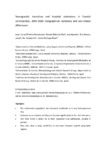Mostrar o rexistro simple do ítem
Demographic transition and hospital admissions in spanish centenarians, 2004–2020: geographical variations and sex-related differences
| dc.contributor.author | Piñeiro-Fernández, Juan Carlos | |
| dc.contributor.author | Rabuñal Rey, Ramón | |
| dc.contributor.author | Maseda, Ana | |
| dc.contributor.author | Romay-Lema, Eva | |
| dc.contributor.author | Suárez-Gil, Roi | |
| dc.contributor.author | Pértega-Díaz, Sonia | |
| dc.date.accessioned | 2024-02-23T08:53:04Z | |
| dc.date.issued | 2024-02 | |
| dc.identifier.citation | Piñeiro-Fernández JC, Rabuñal-Rey R, Maseda A, Romay-Lema E, Suárez-Gil R, Pértega-Díaz S. Demographic transition and hospital admissions in Spanish centenarians, 2004-2020: Geographical variations and sex-related differences. Arch Gerontol Geriatr. 2024 Feb;117:105276. | es_ES |
| dc.identifier.issn | 0167-4943 | |
| dc.identifier.uri | http://hdl.handle.net/2183/35710 | |
| dc.description.abstract | [Abstract] Background: This study aims to describe the distribution and temporal trends of the centenarian population and their hospital admissions in Spain over the past two decades, focusing on regional and sex-based differences. Methods: A retrospective study was conducted using data from the Spanish National Health System's Hospital Discharge Records-Minimum Basic Data Set. The analysis included all hospitalized patients ≥100 years between January 2004 and December 2020. The crude annual centenarian population and admission rates were calculated. Joinpoint regression analysis and cross-correlation analysis were used to identify trends and associations. Results: From 2004 to 2020, the centenarian population in Spain increased by 89.0 %, with a larger increase observed in women (86.6 %) than men (32.9 %). Significant geographic variability was found, with rates from 1.1 to 5.2 × 10,000 inhabitants per year across different regions. Joinpoint analysis identified three trends: a decline from 2004 to 2008, an increase from 2008 to 2015, and a slower increase from 2015 to 2020. Hospital admissions of centenarians increased by 121.5 %, with a larger increase in women than men (212.1% vs 90.7 %); women represented 75.4 % of admissions. The proportion of centenarian admissions to total hospitalizations showed an upward trend until 2015 and then stabilized; it also varied among regions. Conclusion: There was a significant increase in the centenarian population and hospital admissions of centenarians in Spain. There are regional disparities in their distribution, with women representing a larger proportion of centenarians and hospital admissions. Understanding these trends and differences is crucial for implementing interventions that ensure adequate healthcare for centenarians. | es_ES |
| dc.language.iso | eng | es_ES |
| dc.publisher | Elsevier | es_ES |
| dc.relation.uri | https://doi.org/10.1016/j.archger.2023.105276 | es_ES |
| dc.rights | Creative Commons Attribution-NonCommercial-NoDerivs 4.0 International License (CC-BY-NC-ND 4.0) | |
| dc.rights.uri | https://creativecommons.org/licenses/by-nc-nd/4.0/ | |
| dc.subject | Aged | es_ES |
| dc.subject | 80 and over | es_ES |
| dc.subject | Longevity | es_ES |
| dc.subject | Population dynamics | es_ES |
| dc.subject | Hospitalization | es_ES |
| dc.subject | Gender characteristics | es_ES |
| dc.title | Demographic transition and hospital admissions in spanish centenarians, 2004–2020: geographical variations and sex-related differences | es_ES |
| dc.type | info:eu-repo/semantics/article | es_ES |
| dc.rights.access | info:eu-repo/semantics/embargoedAccess | es_ES |
| dc.date.embargoEndDate | 2025-02-01 | es_ES |
| dc.date.embargoLift | 2025-02-01 | |
| UDC.journalTitle | Archives of Gerontology and Geriatrics | es_ES |
| UDC.volume | 117 | es_ES |
Ficheiros no ítem
Este ítem aparece na(s) seguinte(s) colección(s)
-
GI-GIGG - Artigos [114]







